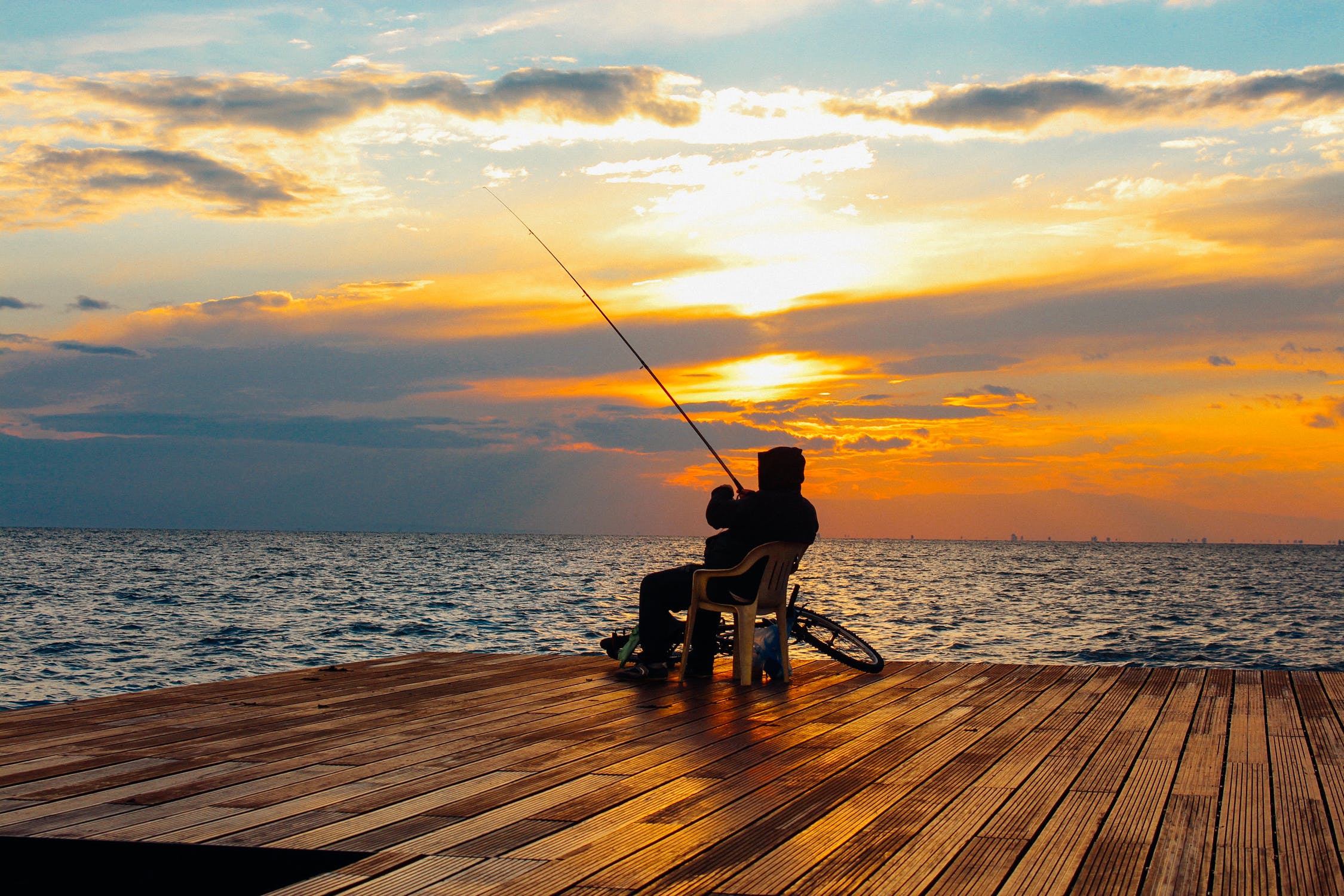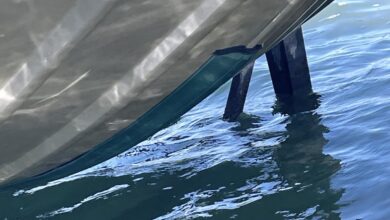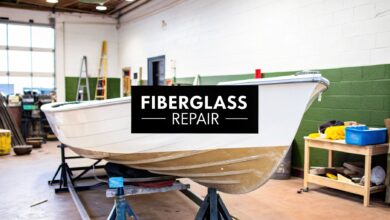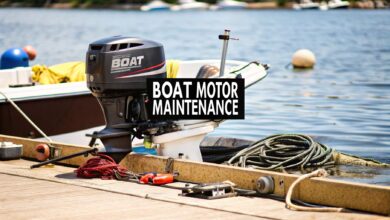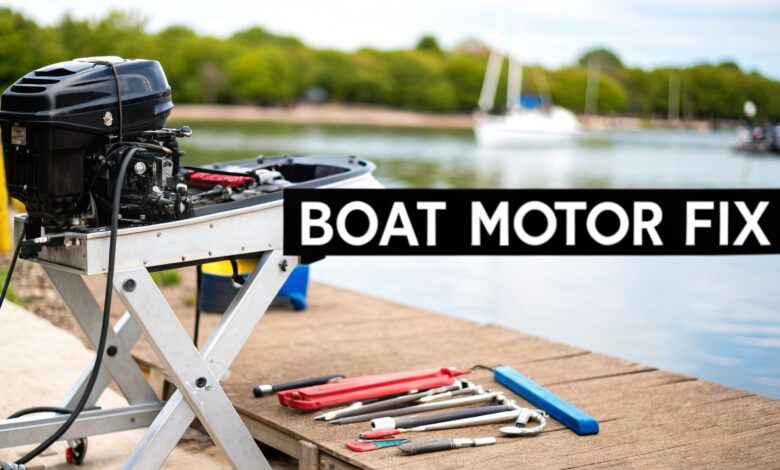
When your boat motor refuses to start, check the simplest things first. Make sure the kill switch lanyard is attached and the shifter is in neutral. These two simple items are often the culprit behind a no-start issue.
What to Do When Your Engine Won't Start
Every boater knows that gut-sinking feeling when you turn the key and get nothing. Instead of panicking, it's time to work the problem methodically. Your first job is to determine if you have an electrical, fuel, or simple oversight issue.
Pay attention to what you hear when you turn the key. A single, sharp click usually means the starter isn't getting enough power. A slow, struggling crank is a classic sign of a weak battery.
If you get complete silence, start your search with the electrical system, beginning at the battery.
Ruling Out the Obvious First
Most no-start problems are actually the easiest to fix. Before you grab your tools, run through this quick list.
- Kill Switch: Is the safety lanyard clip firmly in place? This is the #1 reason an engine cranks but won't fire up.
- Shifter Position: Double-check that the gear shift is locked securely in neutral. Outboards have a safety switch to prevent starting in gear.
- Battery Connections: Are the terminals on your battery clean and tight? A loose connection can stop the starter from drawing enough power.
This quick diagnostic table can help you narrow down the issue even faster.
Quick No-Start Diagnostic Checklist
Use this table for a rapid assessment when your engine fails to start. This helps pinpoint the likely cause.
| Symptom | Potential Cause | Immediate Action |
|---|---|---|
| Nothing happens (no click, no crank) | Kill switch off, dead battery, or loose connection. | Check kill switch lanyard. Inspect and tighten battery terminals. |
| Single, loud click | Low battery voltage or faulty starter solenoid. | Test battery voltage. Tap the starter gently with a hammer. |
| Engine cranks slowly | Weak battery or corroded/loose cables. | Charge and test the battery. Clean all cable connections. |
| Engine cranks but won't start | Fuel issue (empty tank, bad fuel) or no spark. | Check fuel level and prime the bulb. Pull a plug to check for spark. |
Once you've run through these initial checks, you can move on to more involved diagnostics if needed.
This visual guide breaks down the next logical steps for troubleshooting.
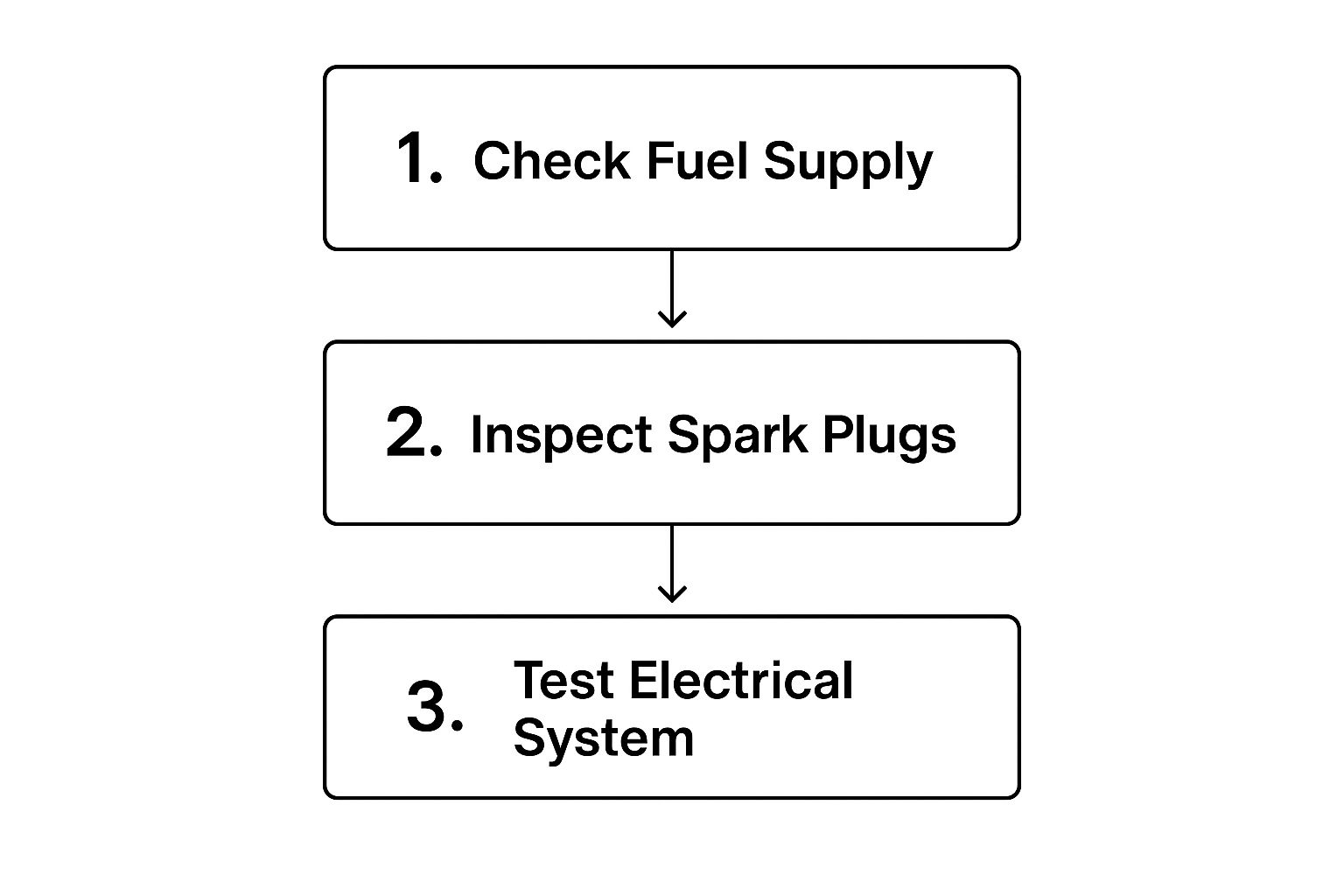
The flowchart shows a clear path from fuel to spark and electrical systems. Following a consistent process like this is the secret to finding the problem quickly. Many of these checks are part of a good boat motor maintenance routine.
Uncovering Common Fuel System Problems
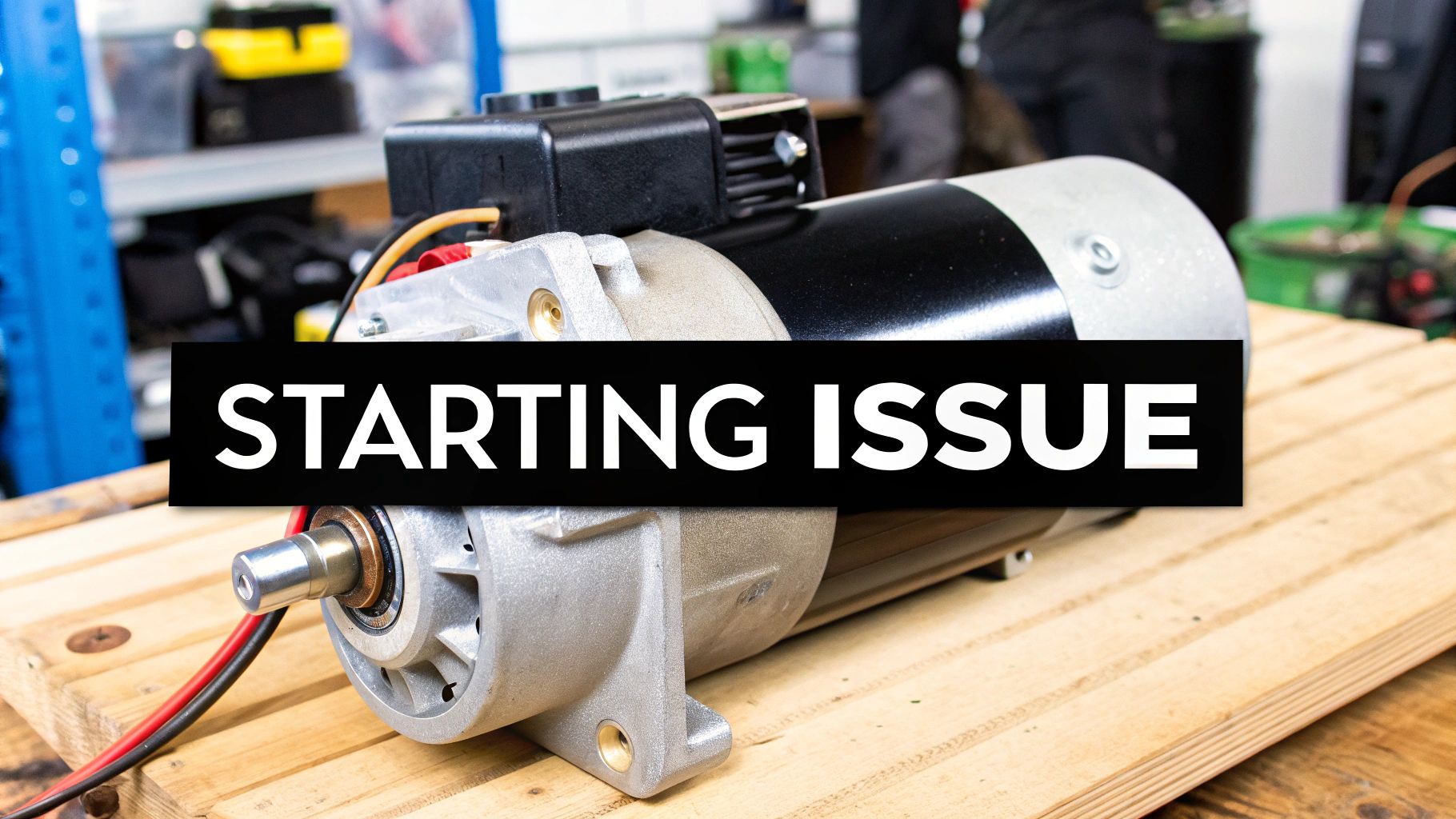
It’s an old saying: many engine troubles start and end with the fuel system. The good news is that you can often track down and fix these problems yourself.
Your first point of investigation should be the primer bulb. Give it a squeeze. If it gets firm, it's full of fuel and working correctly.
If it stays soft, you likely have an air leak or a blockage. This stops fuel from being pulled from the tank.
Finding Fuel Contamination
After checking the bulb, move on to your fuel-water separator filter. Most have a clear bowl for a quick visual check. Look closely for a distinct layer of water or black specks.
Both are telltale signs of contaminated fuel. This is a surefire way to kill your engine's performance.
Pro Tip: A blocked fuel tank vent is a sneaky problem that can mimic major engine failure. This tiny obstruction creates a vacuum in your tank, stopping fuel flow. Check this vent for insect nests or other gunk.
The outboard motor market is booming, expected to hit $6.1 billion by 2030. As engines get more advanced, knowing your way around the fuel system is crucial.
Getting a handle on these issues is key to a long-lasting engine. This guide on diagnosing and preventing boat fuel issues is a great resource. You can find more prevention advice in our article with 8 tips for maintaining your outboard motor.
Solving Your Engine's Electrical Mysteries
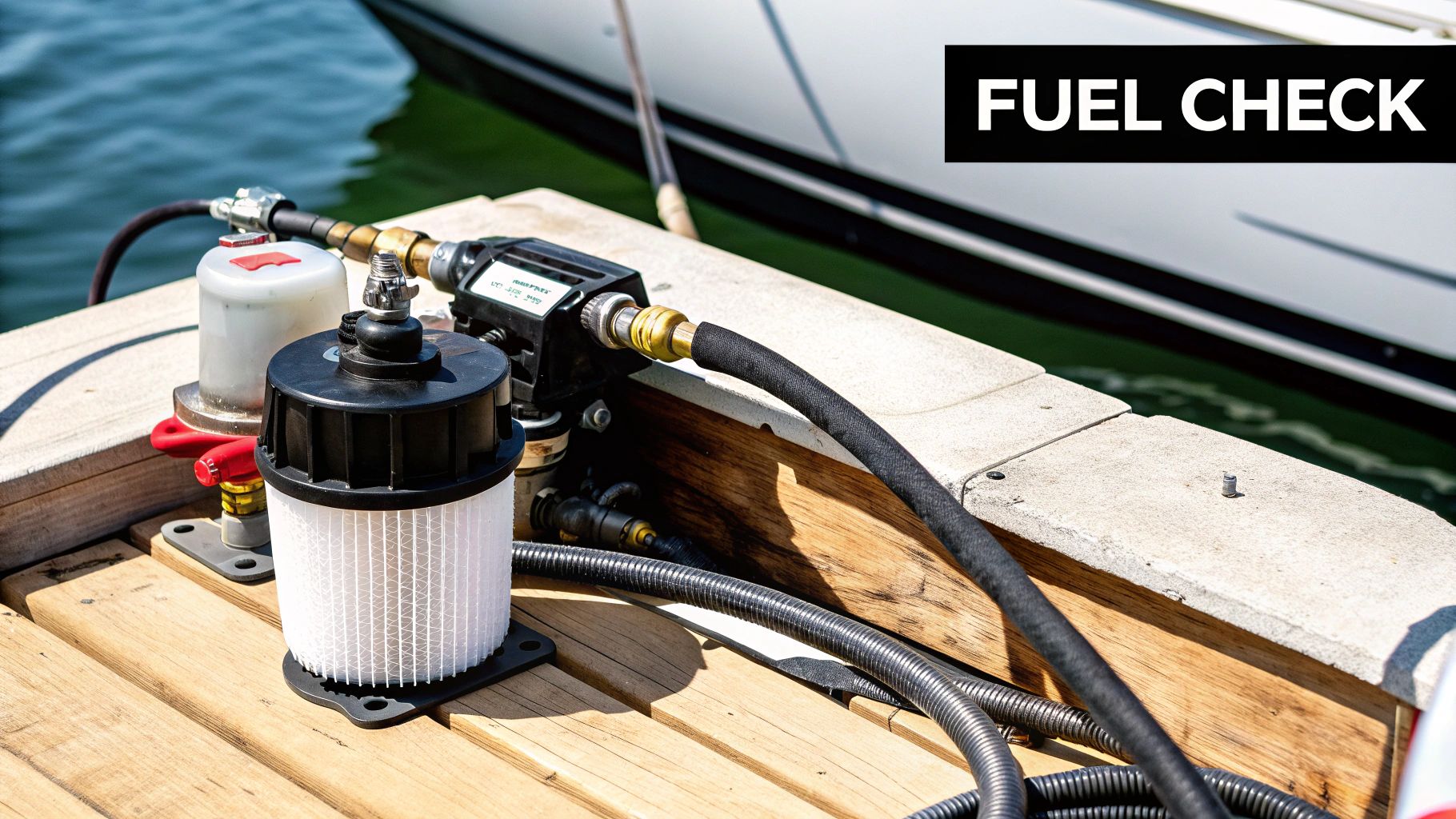
Electrical gremlins can feel intimidating, but a logical approach helps. You can track down most issues without calling a pro. The best place to start is almost always at the battery.
A common situation is a battery that seems fine. Cabin lights work, but the engine only clicks or is silent. This happens because accessories draw little power, while a starter needs a massive jolt.
An aging or drained battery often lacks the punch required to start the engine.
Diagnosing Connections and Fuses
Before you condemn the battery, look closely at the terminals. Any white or greenish, crusty buildup is corrosion and it's a power killer. It chokes the flow of electricity at the source.
Give the main battery cables a good wiggle. A loose terminal nut is a common cause of a "dead engine." This simple fix prevents frustrating and intermittent problems.
Next, check the fuses and circuit breakers. These are designed to fail to protect more valuable components. A blown fuse is the prime suspect if your ignition system suddenly dies.
When tracing wires, be prepared for some surprisingly complex boat engine wiring issues. Understanding the system's layout can save you a world of headache.
As engines evolve, so does their wiring. The inboard engine market is projected to hit nearly USD 3.01 billion by 2034. These newer systems often come with more sophisticated electronics.
How to Handle an Overheating Engine
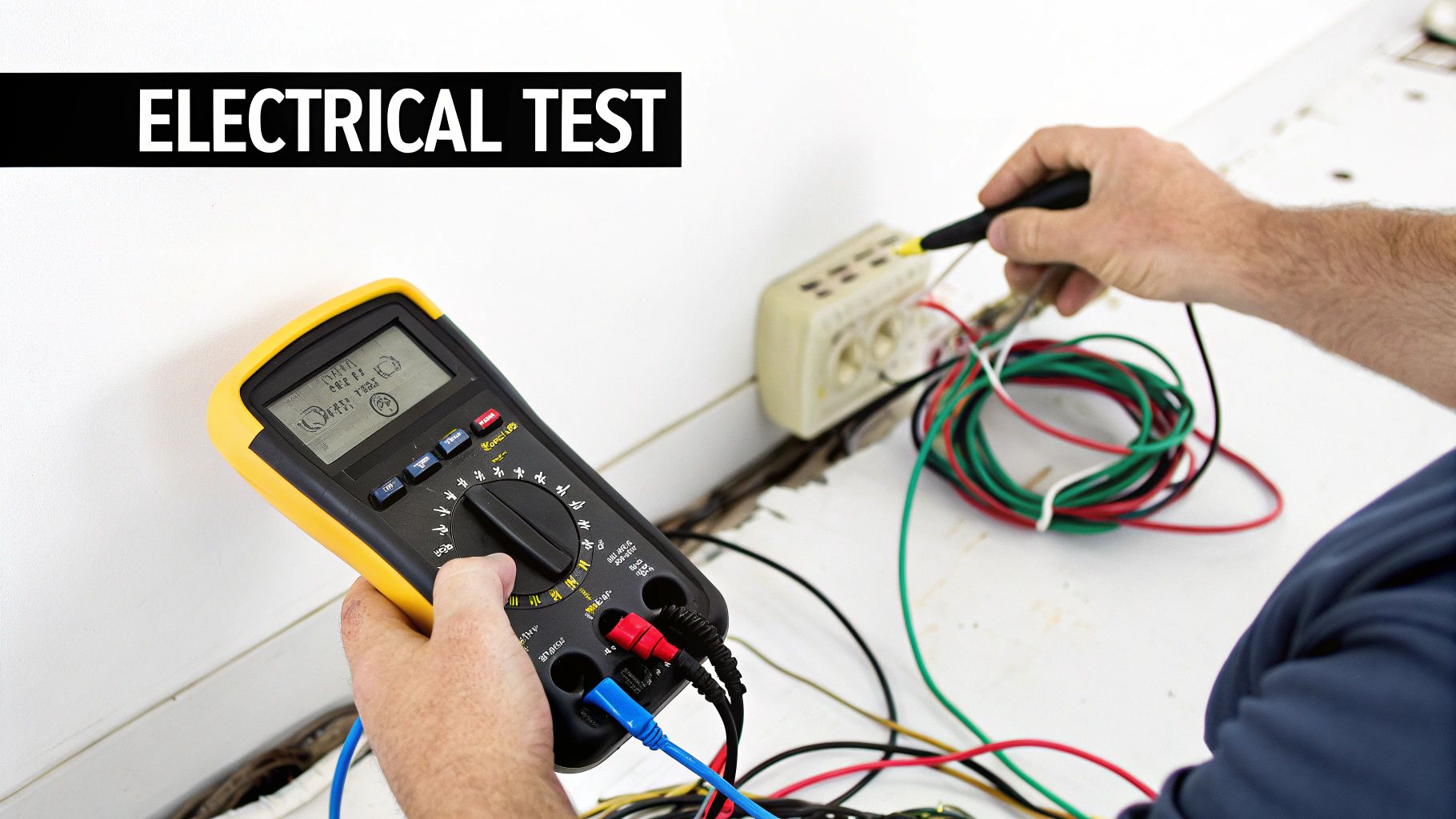
A high-pitched, steady alarm from your console is a serious problem. An overheating engine demands immediate action. Your first and only move should be to shut the engine off right away.
Running an overheating engine, even for a minute, can cause catastrophic damage. This can lead to warped cylinder heads and a massive repair bill. Kill the engine, let things cool, and then figure out what went wrong.
Your first clue is the telltale stream of water shooting from the motor. It confirms the cooling system is pulling in water and doing its job. You want to see a strong, consistent stream.
Diagnosing the Water Flow
If the telltale stream is weak, sputtering, or gone, you've found your culprit. Start with the simplest fix. Look at the water intake vents on the lower unit of your motor.
These vents often get clogged with seaweed, mud, or plastic bags. A quick clean-out with your hand can get you running again.
If the intakes are clear but the stream is still weak, your problem is likely deeper. The next component to suspect is the water pump impeller. This small, rubber part sucks raw water into the engine.
Think of an impeller like tires on a car—it’s a critical wear item. The rubber gets brittle, and fins can break off or wear down. When it fails, it can't move water effectively.
A bad impeller can cause an engine to overheat in less than a minute. Look for these classic signs:
- A very weak stream, even with some throttle.
- An intermittent flow that spits and sputters.
- The engine overheats at idle but cools down on plane.
This is why replacing the impeller should be part of your annual service routine. It’s a cheap part that prevents an expensive failure.
Knowing When to Call a Marine Mechanic
Part of being a good troubleshooter is knowing your limits. There are times when the best move is to call a certified marine technician. It’s about making the smart, safe, and cost-effective choice.
Diving into a complex repair without proper training can turn a small problem into a big one. Recognizing your mechanical boundaries is as important as knowing safe waters. For more on safety, read up on key boating rules and regulations.
Red Flags That Demand a Professional
If you run into these symptoms, your next call should be to a pro. These issues often point to deeper problems that need an expert's eye.
- Internal Metallic Noises: Grinding, heavy knocking, or clanking from the engine is a stop-everything-now warning.
- Persistent Electrical Gremlins: If you've checked fuses and connections but a system keeps shorting out, you may have a hidden short.
- Significant Loss of Compression: This requires a compression tester to confirm and often means serious internal damage.
The global boat maintenance and repair market was valued at around USD 15.5 billion in 2023. This number shows how many boaters depend on professional expertise for complex jobs. You can discover more insights about these market trends to see why skilled mechanics are so indispensable.
Got Questions? We've Got Answers
Even seasoned boaters run into head-scratchers. Here are a few common questions we get about engine troubles.
Why Does My Boat Motor Keep Stalling at Low Speeds?
If your motor dies at idle, it's likely a fuel or air issue. Clogged idle jets in the carburetor are a common culprit. This happens when old fuel, especially with ethanol, sits and turns to gunk.
This blockage throws off the air-fuel mix needed for low RPMs. An incorrectly set idle speed or a vacuum leak could also be the problem. Try running a fuel system cleaner through fresh, non-ethanol fuel first.
Stalling issues show why fuel quality is everything. Around 90% of engine performance problems start in the fuel tank. A good fuel stabilizer is the cheapest insurance you can buy.
What's the Deal With a Weak Telltale Stream?
A weak, sputtering stream is a red alert that your engine is not getting enough cooling water. Shut it down immediately to avoid catastrophic overheating.
The most frequent cause is a failed water pump impeller. It's a rubber part that wears out and needs regular replacement. Before tearing into it, check for obvious blockages like weeds or mud at the intake vents.
How Do I Know if My Fuel Has Gone Bad?
Bad gas is easy to spot once you know what to look for. Siphon a little fuel into a clean glass jar. Let it settle for a few minutes and check it.
Here's what you're looking for:
- Separation: Water will sink to the bottom, forming a distinct layer.
- Debris: Little black specks, dirt, or other junk are bad signs.
- Color and Smell: Old fuel often gets dark and syrupy, with a sour smell unlike fresh fuel.
For more hands-on guides and deep dives into everything from outboard maintenance to advanced navigation techniques, check out our full library at Boating Articles. We have all the resources you need to stay safe and confident on the water, available at https://boating-articles.com.
